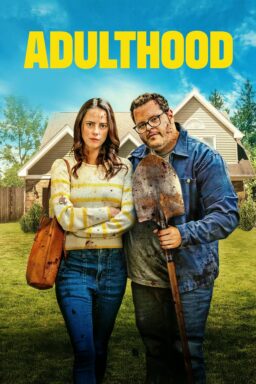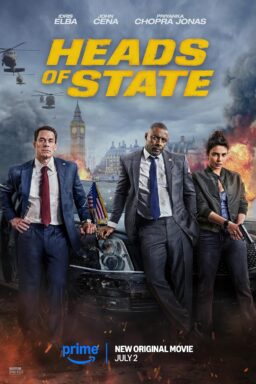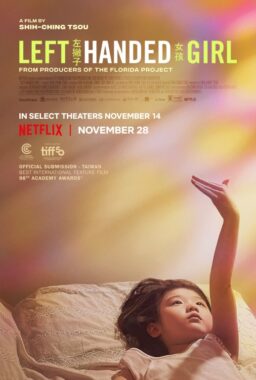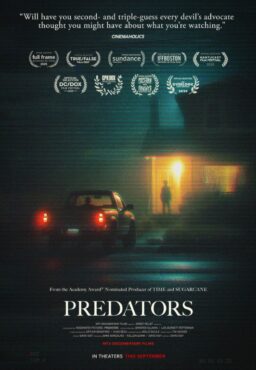Ebert’s Best Film Lists1967 – present
Two of the best performances of the year were in the best film of the year, a heartbreaking, tragic love story set against the seamy backdrop of Las Vegas. Nicholas Cage played an alcoholic Hollywood executive who loses his family, his job and his self-respect, and comes to Vegas determined to drink himself to death. Elisabeth Shue is the hooker who meets him on the Strip, and finds that her heart is touched by his helplessness. “You can never, ever ask me to stop drinking,” he warns her, and she agrees. And for a brief time they are able to hollow out a little happiness in their cave of despair. The movie is operatic in its emotions; the characters may seem like small, unremarkable people, but the film finds heroism and grace in their decisions, and the closing scenes are not only heartbreaking but somehow transcendent. Mike Figgis, whose credits include “Stormy Monday” and “Internal Affairs,” directed; he used a 16mm camera to move freely through Las Vegas, without the delays and formality that come along with a big crew. The result is an unforced authenticity; Cage and Shue really seem present in the streets and casinos, living their lives in a city whose indifference is one of its charms. When I’ve recommended this film, people have sometimes told me they heard it was “depressing.” My answer: No great film is depressing. All bad films are.
Like many great documentaries, this one defies description. It is easy enough to tell you what it is “about,” but almost impossible to capture its mixture of oddness, madness, eccentricity, mental anguish, and defiant triumph. The movie tells the story of R. (for Robert) Crumb, a scatological comic artist who emerged from the San Francisco underground of the 1960s, and continues to flourish today. Many of Crumb’s images, like the “Keep On Truckin'” drawing, have become famous. Not so well known is his appalling private life. He came from a profoundly dysfunctional family, and during the movie we meet his mother and two brothers, all articulate, gifted, fascinating, and disturbed. He says that only his art kept him sane and functioning, and by the end of the movie we agree. And we will not soon forget meeting a brother who still lived in the room he had as a child, and feared to leave the house. Crumb’s art is often deliberately offensive. As he pages through his high school yearbook, naming his old enemies, we realize it is also highly autobiographical. He might never have revealed this side of himself had it not been for the persistence of the filmmaker, Terry Zwigoff, a longtime friend. The result is a film that is literally about the saving power of art.
This remarkable film was screened in December for Academy consideration, and will open around the country in the weeks to come. It is the kind of movie that ennobles filmmaking, by taking an inflammatory subject and considering it fairly and unblinkingly. The movie stars Susan Sarandon as a nun who receives a letter from a condemned man on Death Row, asking for a visit. So, she visits him. The man, played by Sean Penn, is a murderer and a rapist. Ancient Hollywood formulas would lead us to expect that Penn will be revealed as innocent, that Sarandon will save him, that they will fall in love, that she will help him escape, or the plot will lead to other such formulas. This is not that kind of movie. It is intensely focused on who these people really are, and the world they really live in. For the nun, that means getting to know the parents of Penn’s victims–bitter people who do not understand why she visits the killer of their children. Sarandon herself is often appalled by the convict, but she through to the soul beneath. The movie is profoundly Christian in the way it separates the sinner from the sin, suggests we must love our enemies, and allows us to empathize with (but not forgive) the killer. Susan Sarandon and Sean Penn give performances of astonishing power.
Oliver Stone’s biography shows Richard M. Nixon as a brooding, suspicious man whose political brilliance was matched with a knack for self-destruction. The film begins with Nixon fumbling with a recorder while listening to the infamous White House tapes, and then it flashes back to consider his lifelong pattern of following a victory with a defeat. When he finally reached the highest office, no one could defeat him but himself–and he pulled that off. Anthony Hopkins wisely avoids a Nixon impersonation and instead goes for the essence of the man, who remains awkward and evasive even in private moments, and yet is able to score historic milestones, such as the opening with China, and nuclear treaty with Russia, and the winding-down of the Vietnam war. Stone surrounds him with great supporting performances, including Joan Allen as a strong-willed Pat Nixon and Paul Sorvino as the brilliant and sometimes incredulous Henry Kissinger. There is controversy over the accuracy of Stone’s version of “Nixon,” as there was (to a much greater degree) over his “JFK.” The important thing to remember is that this is (ital) Stone’s (unital) version–not objective historical truth, but an artistic interpretation. Like Shakespeare’s Richard III, Robert Graves’ Claudius and Gore Vidal’s Lincoln, this is a portrait that uses the materials of life but does not pretend to be a factual record.
Martin Scorsese’s film about the mob in Vegas in the 1970s is a virtuoso combination of drama, comedy and documentary; much of its first hour is voice-over narration, explaining how gangsters took over Vegas casinos, shipped stolen profits back east, and then began to sew the seeds of their own destruction. (It is easy to imagine that the mob could steal from slot machines–but this movie explains how they dealt with those tons of quarters.) The movie stars Scorsese pals Robert De Niro and Joe Pesci as a casino boss and a street thief who knew each other as children in Chicago, and whose destinies overlap in Vegas. While De Niro tries to keep the lid on the maximize mob profits, the Pesci character establishes himself as “the mob’s Vegas enforcer” (not true) and manages to bring down the whole house of cards. Some critics complained that the movie was just a retread of De Niro and Pesci in Scorsese’s “GoodFellas,” but that’s not fair; using the same actors, Scorsese finds a different style, milieu and purpose, and his movie is interesting both for its characters and its wealth of information.
Ron Howard’s film was about one of the epic voyages of our century, and its nearly tragic end. The Apollo 13 mission to the moon was interrupted by an exploding oxygen tank and a chain of onboard problems that almost marooned the astronauts in space. The film follows, almost second by second, as a strategy is devised to use the resources in the space capsule for a hazardous return to earth.
Howard is good at ensemble films (he made “Backdraft,” “Parenthood,” “Cocoon” and “The Paper“), and here he assembles three astronauts (played by Tom Hanks, Bill Paxton and Kevin Bacon) and a ground team including a bumped astronaut (Gary Sinese) and a determined controller (Ed Harris) in a quick-cutting story of improvisation under fire. The movie’s special effects are particularly impressive; the blast off, outer space and re-entry footage look so real, indeed, that Howard made it a point to announce that every shot was made from scratch. The result is an inspiring reminder that the spirit of exploration that got us to the moon has lagged lately.
In a year when “Showgirls” brought the shadow-world of “gentleman’s clubs” into the glare of publicity, here was an intriguing, complex and surprisingly moving film set in the same milieu. Atom Egoyan’s story is a labyrinth, winding seductively into the darkest secrets of a group of people who should have no connection with one another, but do. At the beginning, the film seems to be about randomly selected strangers. By the end, it is revealed that these people are so tightly wound up together that if you took one away, their world would collapse. Mia Kirshner stars, as Christina, a table dancer in a club with strict rules: The customers may not touch the dancers. One day one customer does, and is banished, setting in motion a series of revelations. One of her regular customers, played by Bruce Greenwood, spends hours with her–but his need doesn’t seem to be sex. What is their real relationship? In the way he unfolds his story, Egoyan shows the same disorienting mastery of time that audiences enjoyed so much in Tarantino’s “Pulp Fiction.” But in the way he develops the characters, he shows a mastery, too, of human nature.
Gregory Nava’s “My Family” is like a family dinner with everybody crowded around the table, remembering good times and bad, honoring those who went before, worrying about those still to come. It is an epic told through the eyes of one family, the Sanchez family, whose father walked north to Los Angeles from Mexico in the 1920s, and whose children include a writer, a nun, an ex-convict, a lawyer, a restaurant owner, and a boy shot dead in his prime. The movie is beautifully photographed, and lovingly recreates the period details, as a humble house in the shadow of a Los Angeles bridge grows to encompass one generation after another. There are warm, resonant performances by the cast, which reads like a roll-call of important Latino stars. And the screenplay, by Nava and his wife Anna Thomas (who also wrote the Oscar-nominated “El Norte“) opens its arms wide and embraces all the facets of this family: Legend, religion, music, pride and shame, triumph and loss.
The year’s unlikeliest love story involved the British writer Lytton Strachey and the painter Dora Carrington, who fell in love as soon as they met and lived together for years, although he was homosexual and they both had a series of other lovers. It was a meeting of the minds, and Jonathan Pryce and Emma Thompson display those minds admirably in barbed wit and ironic understatement. The writer and director, Christopher Hampton, places them in of the Bloomsbury group, that eccentric collection of British artists and intellectuals, but shows how they defined their own lives in a personal space no one else really violated, and few understood.
From Alfonso Arau, the director of “Like Water for Chocolate,” this is a romantic fantasy, aflame with passion and bittersweet longing. One needs perhaps to have a little of these qualities in one’s soul to respond fully to the film, which to many critics looked like overworked melodrama, but to me sang with innocence and trust. Keanu Reeves and Aitana Sanchez-Gijon co-starred, as a homeless soldier just home from World War II, and a single young woman returning, pregnant, to her family’s California vineyard. To save her shame, he agrees to pose as her husband, and then to their amazement they really do fall in love. The family is beautifully cast, especially Giancarlo Giannini as an outraged father and Anthony Quinn as a wise grandfather. The cinematography by Emmanuel Lubezki is ethereal, as in magical scenes like the one where the family uses big butterfly wings to protect the crop against frost. Unashamedly, gloriously romantic.
At most film festivals, there is something called the “Special Jury Prize,” which is given by the jury to a film that is not quite the grand prize winner, but clearly too good for second place. Again this year, I am awarding my own special prizes to five films, which are tied as runners-up to the top ten. Alphabetically: “The American President” was a smart and sparkling comedy starring Michael Douglas as a widower who, as President, found it extraordinarily difficult to have a private life–especially after he fell in love with a lobbyist played by Annette Bening. It was a love story, a drama, and a political picture, all wrapped into one by director Rob Reiner, and one of the year’s best entertainments. “Babe.” I searched and searched for a place in my Top 10 for this charming and unusual film, about a pig that believes it is a sheep dog. Director Chris Noonan was incredibly ingenious in combining real animals, animation, muppets and special effects into an absolutely convincing collection of animals, and James Cromwell and Magda Szubanski were a surprise as the farmer and his wife: Not kiddie movie cliches, but oddball and enchanting originals. “Before the Rain.” Milcho Manchevski’s film was the best of those nominated last spring for the foreign film Oscar, and now, with American troops in Bosnia, it is even more timely. He tells three interlocking stories about long memories and old wounds in Macedonia, another province of what used to be Yugoslavia. The middle story, set in London, casts a cold light on the other two, suggesting that no war is too far away to touch us. The hero of the film hopes to stand above the old hatreds, but is not allowed to. Imagine a culture where a man would rather kill his daughter than allow her to love a man from another culture, and you will have an idea of the depth of bitterness in this film, the insane lengths to which men can be driven by belief and prejudice. “Rob Roy” contained, apart from anything else, the best swordfight in modern movie history, between Liam Neesen and Tim Roth. It also contained an uncommonly intelligent story and colorful characters, and although it was marketed as a swashbuckler it was much more. Director Michael Caton-Jones took the creaky Walter Scott novel and breathed fire into it, not by dumbing it down into an action picture, but by clearly seeing its human rivalries. “Toy Story” was one of the year’s real delights, an animated fantasy about a child’s toys, which come to life and engage in what seem to them like a terrifying journey and amazing adventures. Director John Lasseter achieved all of his effects on computers–but it’s imagination, not technology, which makes the movie so special.
The next ten of the year’s best films, again alphabetically: Mel Gibson’s “Braveheart” was a full-throated Scots adventure, with spectacular battle scenes. Clint Eastwood’s “Bridges of Madison County,” starring Eastwood and Meryl Streep, was delicate and emotionally observant in its story of a brief love affair that resonated for the rest of two lifetimes. Barry Sonnenfeld’s “Get Shorty” was the first movie to truly capture the exuberance of Elmore Leonard’s prose, and had droll performances by John Travolta, Danny De Vito and Gene Hackman. Claude Lelouch’s “Les Miserables” was a virtuoso epic, set mostly in the years before and during World War Two, but drawing on Victor Hugo’s story for flashbacks, and for present-day inspiration; the great veteran Jean-Paul Belmondo moved effortlessly between multiple roles. Woody Allen’s “Mighty Aphrodite” used a Greek chorus to point out the parallels between its modern tale of a sportswriter and a hooker, and the verities of ancient tragedy; Mira Sorvino was touching and hilarious as the woman. Toni Collette sparkled in the title role of P. J. Hogan’s Australian film “Muriel's Wedding,” about an unpopular girl who refuses to accept her fate without a struggle. From New Zealand, the powerful family drama “Once Were Warriors” starred Rena Owen and Temuera Morrison as a Maori couple, trapped in alcoholism and abuse; she fights her way free, in one of the year’s best performances. Roger Mitchell’s “Persuasion” was the best of the year’s Jane Austen adaptations, with its austere settings and repressed silences showing how clearly social mores limited the freedom of the characters; Amanda Root and Ciaran Hinds played the couple almost fated never to find happiness. Kathryn Bigelow’s “Strange Days” was one of the year’s most visionary films, a fantasy about Los Angeles in the grip of quick fixes of virtual reality; the cinematography by Matthew F. Leonetti created a world that was futuristic, startling and yet convincing. And an Italian movie named “The Postman” had a bittersweet triumph; it told the story of a wary friendship between an exiled poet (Philippe Noiret) and a humble mailman (Massimo Troisi), charmed audiences–and saddened them when they learned that Troisi died only a day after finishing the film.
The year 1995 was not, by general agreement, one of the great years in recent cinema (1993 holds that honor), but it had its share of films that tried hard to be better and different. In addition to the titles already listed, let us not fail to pay honor to the following movies, any of which I would gladly see again right now: “Before Sunrise,” “Brothers McMullen,” “Clean, Shaven,” “Clueless,” “Copycat,” “Georgia,” “Heat,” “Kids,” “Little Princess,” “Month by the Lake,” “New Jersey Drive,” “Pocohontas,” “Sabrina,” “Safe,” “Secret of Roan Inish,” “Seven,” “Smoke,” “Stuart Saves his Family,” “Theremin,” “To Die For,” “Unzipped,” “While You Were Sleeping,” and “Wings of Honneamise.”
And in closing let us also praise “Taiga,” Urike Ottinger’s 480-minute documentary about the nomadic reindeer herders of Siberia. I had originally included it in the previous paragraph, until rigorous honesty forced me to admit that, having seen it once, I would not gladly see it again right now.











